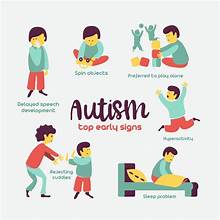Autism Spectrum Disorder (ASD) is a complex developmental condition that affects individuals in various ways, influencing their social interactions, communication skills, and behavior patterns. On World Autism Awareness Day 2024, it’s crucial to delve deeper into understanding what autism truly entails and recognizing its symptoms for early intervention and support.
Defining Autism Spectrum Disorder
Autism, often referred to as Autism Spectrum Disorder (ASD), encompasses a broad range of conditions characterized by challenges with social skills, repetitive behaviors, speech, and nonverbal communication. It is a spectrum disorder, meaning that the severity and combination of symptoms can vary widely among individuals.
Exploring the Symptoms of Autism
1. Social Interaction Challenges
Individuals with autism often struggle with understanding and engaging in social interactions. They may find it difficult to make eye contact, initiate or maintain conversations, and interpret social cues such as facial expressions and body language.
2. Communication Difficulties
Communication difficulties are common among those with autism. Some individuals may have delayed speech development, while others may exhibit repetitive or unusual speech patterns. Additionally, understanding the nuances of language, such as sarcasm or idioms, can be challenging for individuals with autism.
3. Repetitive Behaviors and Restricted Interests
Many individuals with autism engage in repetitive behaviors, such as hand-flapping, rocking, or repeating certain phrases or movements. They may also develop intense interests in specific topics or activities, often to the exclusion of other interests.
4. Sensory Sensitivities
Sensory sensitivities are prevalent among individuals with autism. They may be hypersensitive or hyposensitive to sensory stimuli such as lights, sounds, textures, or smells, leading to discomfort or distress in certain environments.
Early Signs and Diagnosis
Early recognition of autism symptoms is crucial for timely intervention and support. Some signs may emerge as early as infancy, while others become more apparent as a child grows and develops. Common early signs of autism include:
- Lack of or limited eye contact
- Delayed speech or language development
- Difficulty understanding and responding to social cues
- Repetitive behaviors or movements
- Sensory sensitivities
A formal diagnosis of autism is typically made by healthcare professionals, such as pediatricians, psychologists, or developmental specialists, based on observations of behavior and developmental milestones.
Navigating Support and Treatment Options
While there is currently no cure for autism, early intervention and support services can significantly improve outcomes for individuals with autism and their families. Treatment plans are often tailored to address specific needs and may include:
- Behavioral therapies to improve social skills and communication
- Speech and language therapy to enhance communication skills
- Occupational therapy to address sensory sensitivities and motor skills
- Educational support and individualized learning plans
Embracing Neurodiversity and Inclusion
As awareness of autism grows, so does the importance of promoting acceptance, understanding, and inclusion of individuals with autism in all aspects of society. Embracing neurodiversity means recognizing and valuing the unique strengths and perspectives of individuals with autism and ensuring they have equal opportunities to thrive.
Disclaimer : इस न्यूज़ पोर्टल को बेहतर बनाने में सहायता करें और किसी खबर या अंश मे कोई गलती हो या सूचना / तथ्य में कोई कमी हो अथवा कोई कॉपीराइट आपत्ति हो तो वह [email protected] पर सूचित करें। साथ ही साथ पूरी जानकारी तथ्य के साथ दें। जिससे आलेख को सही किया जा सके या हटाया जा सके ।














